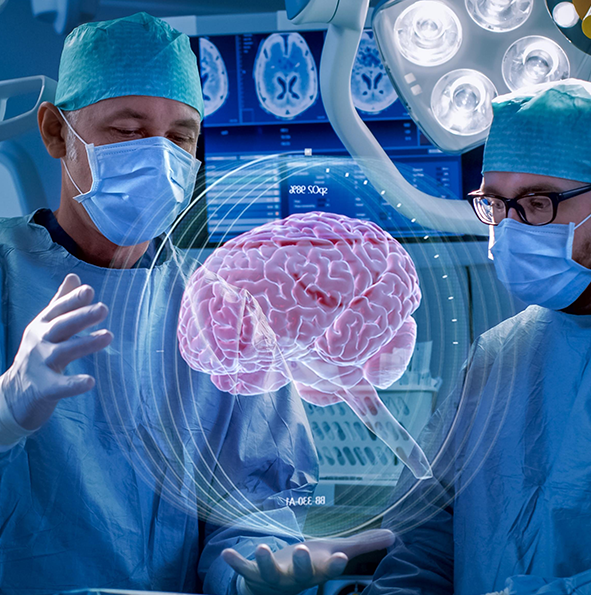Introduction
Trigeminal Neuralgia is a chronic discomfort in the face caused by illnesses that damage cranial nerve V i.e. trigeminal nerve. Injections (e.g., glycerol and Botox injections), drugs (anticonvulsants, antispasmodic medicines), and surgeries (microvascular decompression, brain stereotactic radiosurgery) are some treatment options. Other techniques to treat this condition include radiofrequency thermal lesioning and balloon compression.
Generally, after a diagnosis, medication or one of the surgical alternatives provides relief for many. However, it is more challenging to treat atypical trigeminal neuralgia, which causes a more persistent, searing pain - with both medication and trigeminal neuralgia surgery.
Trigeminal Neuralgia Causes
Trigeminal neuralgia occurs when the trigeminal nerve's normal function is disrupted, often due to compression by a blood vessel at the base of the brain. This pressure, commonly from an artery or vein, hinders the nerve's usual function. While vascular compression is a common cause, other factors like multiple sclerosis, tumors, strokes, facial trauma, and surgical injuries can also lead to trigeminal neuralgia.
Trigeminal Neuralgia Symptoms
Some common Trigeminal Neuralgia Symptoms may manifest as:
-
Intense shooting or jabbing pain resembling an electric shock.
-
Sudden pain episodes triggered by facial touch, chewing, speaking, or teeth brushing.
-
Pain episodes lasting from a few seconds to several minutes.
-
Pain coinciding with facial spasms.
-
Extended episodes of pain, lasting days, weeks, months, or longer.
-
Pain localized in areas supplied by the trigeminal nerve, including the cheek, jaw, teeth, gums, lips, and occasionally the eye and forehead.
-
Unilateral facial pain, affecting one side at a time.
-
Concentrated pain in a specific spot or dispersed in a wider pattern.
-
Rare occurrence of pain during sleep.
-
Gradual escalation in frequency and intensity of pain episodes over time.
When Do You Need Surgery for Trigeminal Neuralgia?
Medication is typically the first line of treatment for trigeminal neuralgia. But medications are required to be taken lifelong , and the effectiveness of the medicines reduces over time, requiring larger doses. Some patients may eventually develop undesirable side effects or cease responding to treatment.
Trigeminal neuralgia surgery has a success rate of over 95%, and the relief is usually immediate and lifelong. Hence surgery can be the treatment of choice for patients with pain that does not subside with medications.
If there is an underlying reason for the disease, such as multiple sclerosis or Herpes ,you will be advised to receive therapy for that ailment first.
Types of Surgery for Trigeminal Neuralgia
Surgery for Trigeminal neuralgia is the most effective treatment for a cure.
-
Microvascular Decompression:This procedure prevents the trigeminal nerve from malfunctioning, by relocating or eliminating blood vessels that come into contact with the nerve. MVD is the treatment of choice in trigeminal neuralgia with a success rate of over 95%, and the relief is usually immediate and lifelong.
Other Procedures May Include:
-
Radiofrequency Thermal Lesioning: This treatment specifically kills nerve fibers related to pain. The surgeon will insert a hollow needle in the patient’s face. The trigeminal nerve passes via an aperture at the base of the skull, and the surgeon guides the needle to that location. Following radiofrequency thermal lesioning, transient face numbness is typically seen. Relief may be achieved for upto a few years, but the pain may return after that.
-
Balloon Compression:A hollow needle is inserted into the face during this surgery. It is directed towards the trigeminal nerve's passage through the base of the skull. After that, the needle is threaded into a thin, flexible tube known as a catheter that has a balloon on the end. Enough pressure is applied to the balloon during inflation to harm the trigeminal nerve and obstruct pain signals.Relief may be achieved for upto a few years, but the pain may return after that.
-
Brain Stereotactic Radiosurgery:Also known as the Gamma Knife, the process involves a targeted radiation dose directed towards the trigeminal nerve root to lessen or cease the pain. The pain subsides gradually and could take a month or longer. For most patients, brain stereotactic radiosurgery effectively relieves pain. However, there is a chance that pain can return after any treatment; this usually happens in three to five years. You may have another trigeminal neuralgia surgery or have the first one repeated if the discomfort returns. Hence it is preferred only in patients unfit for MVD surgery.
Why Choose WIINS Hospitals ?
WIINS Hospitals is an acclaimed center for the surgery of Trigeminal Neuralgia, with an experience spanning over 30 years and 2000 cases treated successfully. We perform this surgery by the Keyhole method leveraging the latest technology such as the Storz Vitom 3D 4K Exoscope. We offer an unparalleled commitment to the patient well-being. Beyond cutting-edge treatment and technology, we prioritize exceptional patient care. WIINS stands out with excellent clinical services and advanced diagnostic facilities. Our highly skilled medical professionals precisely handle surgeries and delicate procedures, while ensuring utmost care. Transparency is at the core of our administration, as we consistently provide clear information on diagnosis, treatment plans, medications, and financial aspects to empower our patients.
